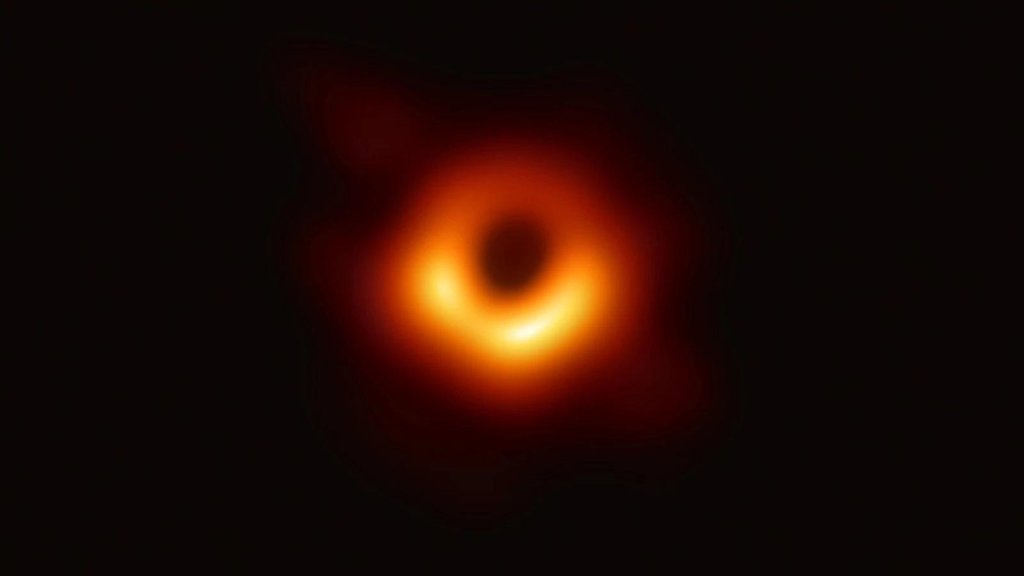Astronomers have managed to capture the image of a black hole for the very first time. The black hole in question is located in the middle of the Messier 87 galaxy, which rests some 55 million light years away from Earth.
The black hole itself cannot, technically, be seen, but the photo shows us the halo of dust and gas that surrounds it, tracing its shape.
Keep in mind that any other image of a black hole you’ve seen so far (including the one from Interstellar) did not have a photo as their foundation and have been merely artistic interpretations, out of which only a very small number have been based on the available scientific data.

Einstein was the first one to predict black holes, through its theory of relativity but even he, at the time, was skeptical concerning their existence. Since then, scientists have gathered more than enough data to attest for the fact that they are, indeed out there – for example, when black holes collide, they send a swarm of gravitational waves that ripple through space in the same way water ripples in a lake when you throw a stone in it.
The trick was, until now, that black holes are too dark and distant for normal telescopes to catch so the scientists employed the use of the Event Horizon Telescope. This telescope actually used data from eight of the world’s most advanced radio observatories that stretch all the way from the South Pole to Chile.
To give you some understanding on how exactly the telescope works, we first have to tell you that it relies on interferometry – a measurement method that uses the interference of waves (light, radio or sound waves) to measure either the waves’ characteristics or the materials that reflect, refract or transmit them.
All those wave signals that came in from all the eight telescopes had to be combined and then sent into a computer to be transformed into an image we could understand.
If you think this was a huge challenge, you’re not wrong: not only was the amount of data big enough to have to be physically shipped to the MIT Haystack observatory but the scientists also had to filter through the noise that was caused by other factors (such as atmospheric humidity) and synchronize the signals from every telescope with absolute precision.
We have assistant professor of computing and mathematical sciences Katie Bouman from the California Institute of Technology to thank for giving out a helping hand into making the image we see now a reality for all of us: three years ago, while she was still an MIT graduate student, she came up with an new algorithm that helped stitch together all the data that came in from the Event Horizon Telescope.
She also made sure, via a series of tests, that the final image would not be the result of a technical glitch – the algorithms were built with different assumptions into them and each of them tried to recover a photo from the data.
The results were subsequently analyzed by four different teams that made sure the image they saw was the one they were searching for. They were told not to talk to each other or anyone else and to choose the imaging algorithms they assumed were the best and create the images based on that data. The resulting four images were only slightly different from each other.

“No one of us could’ve done it alone,” she said in an CNN interview “It came together because of lots of different people from many different backgrounds.“
The astronomers have been chasing the black holes with the Event Horizon since 2017 and there were a lot of factors to take into consideration, including clear skies on all continents, at the same time and perfect coordination between all the teams at each telescope.
To ensure success, the observations from every telescope were coordinated via atomic clocks, which are accurate to within one second, every 100 years. It was in an April night, that it all finally fell into the right place.
In just one night of observation, the Event Horizon sent just about enough data to fill half a tonne worth of hard drives. They had to wait another half a year for the data from the South Pole, since it could only be shipped out at the end of the arctic winter.
“We’re a melting pot of astronomers, physicists, mathematicians and engineers, and that’s what it took to achieve something once thought impossible,”
Katie Bouman
Even so, the image and all the data that accompanied it, is expected to give the scientists a lot of answers about black holes and even more questions, for a long time to come. But what everyone wants to know the most is what exactly we’ll be able to find inside the black hole – the observations the Event Horizon gathered have not revealed anything about that for the time being.
“The black hole is not the event horizon, it’s something inside. It could be something just inside the event horizon, an exotic object hovering just beneath the surface, or it could be a singularity at the centre … or a ring,” Ziri Younsi, a member of the Event Horizon Telescope said “It doesn’t yet give us an explanation of what’s going on inside.”
As terrifying as black holes are, we’re looking forward to a more high-resolution image in the near future. Until then, we’ll give a round of applause for the scientists who worked tirelessly to try and grasp more of the mysteries of the Universe.
Follow TechTheLead on Google News to get the news first.






















